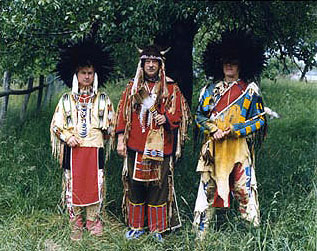Andrea Robbins (United States, born 1963) and Max Becher (Germany, born 1964) have collaborated since 1984 on photographic projects that address cross-cultural influence, or, as they have phrased it, “the transportation of place.” In documentary-style color photographs, Robbins and Becher explore the outward manifestations of how geographically disparate communities and cultures impact one another through “overlapping eras of slavery, colonialism, holocausts, immigration, tourism, and mass-communications.” They research and document places and people that have been displaced or transported, such as the remnants of German colonialism in Africa; towns in America reconstructed to simulate European architectural and cultural themes; German fascination with American Indian culture; and the descendants of African-American slaves living in a secluded pocket of the Dominican Republic.
In documentary-style color photographs, Robbins and Becher explore the outward manifestations of how geographically disparate communities and cultures impact one another…
In the series Colonial Remains (1991), Robbins and Becher photographed German architectural styles and costumes in Namibia. Photographs of Lüderitz, for example, depict an isolated village perched atop barren rocks between the desert and the Atlantic Ocean. Dirt roads, intense blue sky, and harsh shadows emphasize the disjunction between European architecture and African landscape. Now a popular tourist attraction, Lüderitz was originally settled in 1884 by German traders under the protection of Bismarck. In their straightforward and precise approach to documentation, these pictures formally evoke the method of the photographic team of Bernd and Hilla Becher. However, although both artist teams use photography to document architectural and cultural artifacts of earlier historical practices, Robbins and Becher are clearly less concerned with typology than with ethnographic concerns. Other photographs in Namibia capture the Hereros, a regional ethnic group who gather every year in Okahandja to commemorate chiefs who died in the 1908 war of resistance against the German soldiers, a conflict which, according to Robbins and Becher, cost the lives of 75-80% of the Hereros people. These subtle pictures of the procession of men and women become more complex when we learn from the artists’ text panel that the women’s costumes recall the nineteenth-century Victorian dresses of the German colonists.
In the United States, Robbins and Becher have been interested in the ways in which cultural heritage can be commercially manufactured. Their series Bavarian by Law (1995-96) records the “Bavarianization” of Leavenworth, a small town in the Cascade Mountains in northern Washington State. In the 1960s citizens of this economically distressed logging town introduced a mandatory Bavarian architectural style in order to attract tourists. The creation of an “authentic replica” of an Alpine village, where city ordinances require the facades of even McDonalds and BP to conform to traditional Bavarian architectural styles, has been remarkably successful. Robbins and Becher’s photographs document businesses and homes that have been transformed or created as well as cultural festivals in which townspeople dress in traditional costumes and perform a yearly round of Alpine celebrations for the benefit of visiting tourists.
In documentary-style color photographs, Robbins and Becher explore the outward manifestations of how geographically disparate communities and cultures impact one another through “overlapping eras of slavery, colonialism, holocausts, immigration, tourism, and mass-communications.”
In one of the more bizarre cultural dislocations of the past century, there is no country more intrigued with Native Americans than Germany. In addition to the influence of Hollywood stereotypes, this fascination is rooted in the novels of nineteenth-century writer Karl May. May’s portrayal of Native Americans as heroes and whites as villains was itself based not on firsthand experience but on his reading of James Fenimore Cooper’s nineteenth-century work The Leatherstocking Saga, itself a highly imaginary version of Indian life. According to Robbins and Becher, May’s stories are regarded by contemporary Germans as carrying a “progressive, anti-colonial message” that is also “anti-American/anti-capitalist.” The artists also note that, “ironically, while Hitler was researching American Indian reservations as models for concentration camps, he made his generals carry around volumes of Karl May’s writings.”
For their series German Indians (1997-98), Robbins and Becher photographed the annual celebration of Karl May’s birthday in his hometown of Radebeul, near Dresden. Here, German fans gather into tribes, camp in tepees, and dress in carefully detailed Native American regalia. Tourists visit the festival as though it represents a historically correct tableau. Robbins and Becher’s photographs are reminiscent of the early twentieth-century portraits made by Edward Curtis of “real” Indians, whom Curtis asked to pose in staged reenactments of “war parties” and other traditional behavior. While Curtis often provided his subjects with skins and blankets to hide their “modern” European clothing, he also allowed glimpses of contemporary life to show through. This can likewise be seen in images by Robbins and Becher in which German Indians wear white socks, wedding rings, and sit on aluminum and canvas folding chairs with their ice chests nearby. Such juxtapositions subtly destabilize the notion of authentic culture.
… they deliberately employ conventions of the picturesque in an attempt to enhance the often uneventful or mundane scene
The Americans of Samaná (1998-2001) documents the descendants of freed African-American slaves who traveled to the Dominican Republic in 1824 in a scheme initiated and financed by President Pierre Boyer of Haiti, with the cooperation of the American Colonization Society. Today about 8,000 descendants of the original group of thirty-four Protestant families live in a country of Catholic Spanish-Dominicans and speak an antiquated American English. Known as the “Americanos,” they have been perpetual victims of racism encouraged by a succession of dictators who outlawed English and undermined their economic development. Coping with a culture twice removed from their African heritage, many of these individuals identify themselves foremost as American and hope for repatriation. Concerned to confer dignity on their subjects, Robbins and Becher photograph the “Americanos” from a respectful distance and in the tradition of Lewis Hine and Walker Evans, with deliberately chosen contextual details. As in all of the projects of Robbins and Becher, they deliberately employ conventions of the picturesque in an attempt to enhance the often uneventful or mundane scene—a softly lit portrait or a landscape under a “picture perfect” blue sky. Each project is distinguished by a bold color frame and accompanied with historical text panels that further displace the images from the realm of picture-postcard cliché.
Andrea Robbins and Max Becher concentrate on some of the more overlooked cultural dislocations of contemporary times. While globalization as a theme permeates a great deal of art made in the last decade, it tends to be narrowly understood as the outcome of the recent global embrace of free market economic thinking, and other Western values mediated by novel communications technologies. Robbins and Becher direct our attention as well to the idiosyncratic vestiges of prior periods of globalization characterized by entirely different, though similarly globalizing, projects, such as slavery or colonization. In so doing they demonstrate the surprising persistence of culture and its artifacts, however dislocated, and the tendency of history to reassert itself through them, sometimes in the least likely places.

